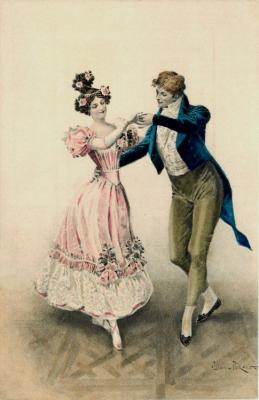
A few years ago, I attended a Regency-themed English Country Dance in a city far from home. It was a beautiful historic venue, the music was good, everyone was well dressed and the dancers were capable, but there was something lacking, something that left me unsatisfied. It took me perhaps longer than it should have to figure out what the problem was: nobody made eye contact.
We went through our figures, took hands on cue and even did some fancy steps from time to time, but almost every time, as I took hands with another person, my eyes were looking at the side of her head while her attention was elsewhere.
This really brought home to me how essential this was: that eye contact in a set dance, whether it was English Country Dance, Contra Dance, Quadrilles, Square Dancing, Scottish Country Dance etc., is not a minor stylistic detail. It is key. In my personal reckoning, the most important thing is correctly following the figure and the music (nothing works if you aren't where you need to be) and the second, and still essential piece, is eye contact.
This is what makes it a "social dance". The whole point of dancing in a group is connecting with the other members of that group. If you hit all your marks and perform all your mechanical functions when you are supposed to do them, while keeping your eyes fixed ahead; you are not undermining the working of the dance, but you are off in your own world. You are dancing alone. The group is dancing together, while you are not fully present. You are just an anonymous cog in the machine, while those who make eye contact are fully present and are connecting with one another. Further, since those who make eye contact are, as I said, fully present, they are better able to coordinate their movements with the other dancers - which makes even the mechanical parts of the dance work more smoothly.
Each interaction, when you take hands with another person and make eye contact, is what you want it to be. It's a brief encounter, a momentary connection with another person and you bring to it what you bring to it. There is no one "right" way to do this. It's all about what feels right to you, and is often influenced by the relationship (if any) you have with the other person and how that person reacts to you.
Some people like to be flirty, or give a slight smile, or be playful, or serene and neutral - or, depending on who is opposite them, all of the above during a single dance; but which ever way you like to go, you should, for that very brief instant, let the other person know that he/she has your undivided attention. I think you will find it makes a world of difference.
As a post-script: I attended a later iteration of that same far-away dance the following year, but made a point of attending the practice session a few days prior, where I very pointedly made eye contact while making personal connections in a far more relaxed setting than a formal ball. When the ball came around, my attempts to make eye contact were widely reciprocated, and I found myself in great demand and I, and I think my partners, had a far better time of it.
From Saltator's dancing manual from 1802:
"The dancer in all his movements is supposed to cast his eyes attentively at his partner, which will of course give proper turn to his person. There is nothing that discovers ill breeding more than to see a gentleman or lady in a dance dragging themselves along with one side or their backs to their partners, which must, if possible, be avoided."
